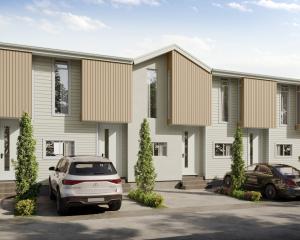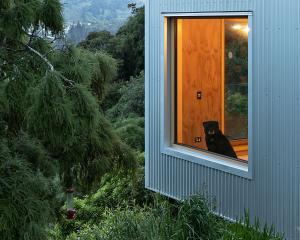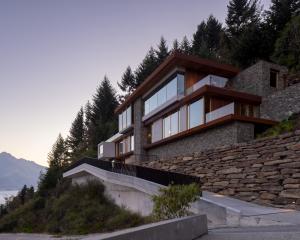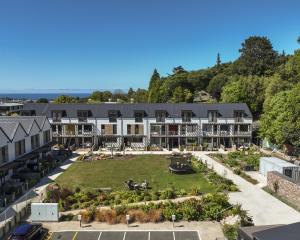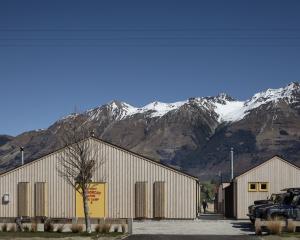
A modestly sized home wrapped in cedar shingles lends handcrafted elegance to a suburban street in Wānaka. The singular material applied to the home’s gable form cuts a striking figure - there’s nothing else like it in the neighbourhood.
The decorative finish is familiar to Scandinavian architecture and often used in Japan, not only for its visual appeal but for weatherproofing. While on a ski trip in Japan, the owners of this home were enlightened by the country’s approach to efficient design. Their holiday accommodation gave them everything the family of five needed, all within a thoroughly considered yet small footprint.
Keen to pursue a similar approach to the design of their own holiday home, the clients approached Condon Scott Architects after seeing Kirimoko Tiny House, which the practice designed on an exceedingly restrained, 30m2 footprint. Built in Wānaka in 2018, its owners were inspired to challenge conventional living after a cycle trip that confined them to essentially living out of bicycle panniers.

Having relished the freedom of minimalism, they decided to apply a living-withless approach to their home. To their delight, Kirimoko delivers all the essentials of a larger home and generosity of scale within its double-height volume gable form. In 2019, the project was the winner in the housing category of Te Kāhui Whaihanga New Zealand Institute of Architects’ Southern Awards. “Despite saving space, none of the essentials are missing. The house was designed as a crafted box where not a morsel of space is wasted,” said the judges.
Condon Scott applied many of the design devices and learnings from Kirimoko to this next project, known as Sugi house (which means cedar in Japanese). Not a millimetre of space has gone unutilised, and the limited exterior and interior material palette enhances the refined aesthetic. As shingles provide a continuous wrap to the exterior, the pared-back theme carries through to the interior where negative-detail plywood lines the walls and ceilings.
Behind this crisp finish, there are clever details to discover, such as concealed storage within stair treads, and space-saving built-in shelving and fireplace. It’s details such as these, and cupboards free of protruding handles, that save space and reduce visual clutter.

The two bedroom, two-bathroom home comfortably accommodates the family and delivers all the requisite comforts of a modern home. Another perfectly wrapped component is the bathroom – a tiled wet room with a walk-in shower, another feature typical in Japanese homes.
The double-height living area adds scale and the mezzanine above the kitchen operates a flexible space, serving as a sleeping area or lounge as required. In summer, glass sliding doors open to a sheltered outdoor sitting area with a barbecue.
“There are a lot of hand-crafted details,” says architect Barry Condon, principal at Condon Scott. “Everything has had to be thoroughly considered and it was really enjoyable to work with a client who wanted to explore these design concepts.”

As with Kirimoko, Sugi was built with Structurally Insulated Panels (SIPs) and to Passive House principles to deliver maximum thermal efficiency in the Southern alpine climate. Double-glazed windows are positioned to maximise sun patterns for solar gain yet keep out the harsh Otago sun. As a result, the only heating required in winter is a wood burner.
In 2021, Sugi House earned Condon Scott another accolade as winner of the New Zealand Institute of Architects Small Project Architecture Southern Awards.
“These projects illustrate very comfortable spaces that function perfectly well,” says Condon, who has noticed more enquiries in recent years from clients seeking efficient solutions to designing, building and living.

The positive outcomes of a well-considered design are manifold and consider the present as well as potential future outcomes. It’s about taking a broader, more holistic view of the lifecycle and long-term sustainability of a home, says Condon. “With the rise in the cost of land and construction materials, more people are considering efficient designs,” he adds, noting the approach has numerous pay offs, including reduced running costs, warmth and comfort, and buildings that endure.
“People are prepared to reduce the square metreage of their homes when they can achieve the quality of construction and finishes that they seek,” he says.

It was this same holistic approach that Siân Taylor and Mark Read of Team Green Architects took when designing their own home near Arrowtown. To achieve their plans to build a three-bedroom home, they started small and with what they could afford. The result is a 70m2, two-storey dwelling that sits beautifully within the landscape.
Among the first Passive House-certified architects in the country, building to low-energy, highly insulated standards were a given. The home contains two bedrooms, a bathroom, lots of storage space and an open-plan living area that connects to the outstanding Southern views through full-height glazing. It’s a hardworking plan that does double duty to deliver a residence, plus a workplace on the second level.


The intention was for the home to eventually become a guest house but after several years of living and working there, the family is so content they have no plans to return to the drawing board and expand.
“I love it – it’s always comfortable, no matter what time of year, which is a really big thing,” says Taylor. Her only lament is the closet full of clothes that go unworn - the temperature of the house remains so stable that they wear T-shirts all-year round.
Due to the modest interior footprint, an unexpected outcome is greater engagement with the outdoors, particularly when numbers swell with social gatherings and the crowd spills outside. “It’s remarkable and creates a really different experience,” says Taylor, who has come to relish cranking up the fire and enjoying the stars.
The beauty of small things, it seems, can be their ability to deliver outsized experiences.
PROJECT TEAM
For more information visit NZIA





